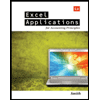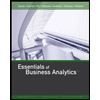
Principles of Financial Accounting.
24th Edition
ISBN: 9781260158601
Author: Wild
Publisher: MCG
expand_more
expand_more
format_list_bulleted
Question
Chapter 6, Problem 5BTN
1.
To determine
Compute the company’s inventory turnover and its days’ sales in inventory under (a) current conditions and (b) proposed conditions.
2.
To determine
Evaluate and comment on the merits of their proposal given your analysis for part, and identify any concerns regarding about the proposal.
Expert Solution & Answer
Want to see the full answer?
Check out a sample textbook solution
Students have asked these similar questions
I need help finding the accurate solution to this general accounting problem with valid methods.
SUBJECT - GENERAL ACCOUNTING
Please help me solve this general accounting question using the right accounting principles.
Chapter 6 Solutions
Principles of Financial Accounting.
Ch. 6 - Perpetual: Assume that Marvel uses a perpetual...Ch. 6 - Perpetual: Assume that Marvel uses a perpetual...Ch. 6 - Perpetual and Periodic: Assume that Marvel uses a...Ch. 6 - Periodic: Assume that Marvel uses a periodic FIFO...Ch. 6 - Prob. 5MCQCh. 6 - A company has cost of goods sold of 85,000 and...Ch. 6 - Describe how costs flow from inventory to cost of...Ch. 6 - Where is the amount of merchandise inventory...Ch. 6 - If costs are declining, will the LIFO or FIFO...Ch. 6 - If inventory errors are said to correct...
Ch. 6 - Prob. 5DQCh. 6 - What is the meaning of market as it is used in...Ch. 6 - What factors contribute to (or cause) inventory...Ch. 6 - When preparing interim financial statements, what...Ch. 6 - Prob. 9DQCh. 6 - Prob. 10DQCh. 6 - Prob. 11DQCh. 6 - Prob. 12DQCh. 6 - Inventory ownership Homestead Crafts, a...Ch. 6 - Prob. 2QSCh. 6 - Computing goods available for sale Wattan Company...Ch. 6 - A company reports the following beginning...Ch. 6 - Perpetual: Inventory costing with FIFO P1 A...Ch. 6 - Perpetual: Inventory costing with FIFO P1 A...Ch. 6 - Perpetual: Inventory costing with FIFO P1 A...Ch. 6 - Perpetual: Inventory costing with FIFO P1 A...Ch. 6 - Perpetual: Inventory costing with FIFO P1 A...Ch. 6 - Perpetual: Assigning costs with FIFO Trey Monson...Ch. 6 - Perpetual: Assigning costs with FIFO P1 Trey...Ch. 6 - Perpetual: Assigning costs with FIFO P1 Trey...Ch. 6 - Perpetual: Assigning costs with FIFO P1 Trey...Ch. 6 - Perpetual: Assigning costs with FIFO P1 Trey...Ch. 6 - Perpetual: Assigning costs with FIFO P1 Trey...Ch. 6 - Perpetual: Assigning costs with FIFO P1 Trey...Ch. 6 - Perpetual: Assigning costs with FIFO P1 Trey...Ch. 6 - Prob. 18QSCh. 6 - Prob. 19QSCh. 6 - Prob. 20QSCh. 6 - Analyzing inventory Endor Company begins the year...Ch. 6 - Prob. 22QSCh. 6 - Prob. 23QSCh. 6 - Prob. 1ECh. 6 - Inventory costs Walberg Associates, antique...Ch. 6 - Perpetual: Inventory costing methods P1 Laker...Ch. 6 - Question: Laker Company reported the following...Ch. 6 - Prob. 5ECh. 6 - Prob. 6ECh. 6 - Perpetual: Inventors- costing methodsFIFO and...Ch. 6 - Question: Refer to the information in Exercise...Ch. 6 - Question: Refer to the information in Exercise 6-7...Ch. 6 - Lower of cost or market Martinez Companys ending...Ch. 6 - Prob. 11ECh. 6 - Prob. 12ECh. 6 - Prob. 13ECh. 6 - Periodic: Cost flow assumptions Lopez Company...Ch. 6 - Periodic: Cost flow assumptions Floras Gifts...Ch. 6 - Prob. 16ECh. 6 - Estimating ending inventorgross profit method On...Ch. 6 - Alternative cost flows Warnerwoods Company uses a...Ch. 6 - Perpetual: Alternative cost flows P1 Warnerwoods...Ch. 6 - Alternative cost flows Montoure Company uses a...Ch. 6 - Perpetual: Alternative cost flows P1 Montoure...Ch. 6 - Prob. 5APCh. 6 - Analysis of inventory errors A2 Navajo Company's...Ch. 6 - Prob. 7APCh. 6 - Periodic: Income comparisons and cost flows A1 P3...Ch. 6 - Prob. 9APCh. 6 - Prob. 10APCh. 6 - Alternative cost flows Ming Company uses a...Ch. 6 - Perpetual: Alternative cost flows P1 Ming Company...Ch. 6 - Perpetual: Alternative cost flows Aloha Company...Ch. 6 - Prob. 4BPCh. 6 - Prob. 5BPCh. 6 - Analysis of inventory errors A2 Hallam Company's...Ch. 6 - Prob. 7BPCh. 6 - Periodic: Income comparisons and cost flows A1 P3...Ch. 6 - Retail inventory method The records of Macklin Co....Ch. 6 - Prob. 10BPCh. 6 - SERIAL PROBLEM Business Solutions P2 A3 This...Ch. 6 - Prob. 1AACh. 6 - Prob. 2AACh. 6 - Prob. 3AACh. 6 - ETHICS CHALLENGE Golf Challenge Corp. is a retail...Ch. 6 - COMMUNICATING IN PRACTICE You are a financial...Ch. 6 - Prob. 3BTNCh. 6 - Prob. 5BTN
Knowledge Booster
Learn more about
Need a deep-dive on the concept behind this application? Look no further. Learn more about this topic, accounting and related others by exploring similar questions and additional content below.Similar questions
- Can you solve this general accounting problem with appropriate steps and explanations?arrow_forwardI am trying to find the accurate solution to this general accounting problem with the correct explanation.arrow_forward← Week 1: Homework Question 3 of 4 8.75/10 The project is completed in 2025, and a successful patent is obtained. The R&D costs to complete the project are $113,000. The administrative and legal expenses incurred in obtaining patent number 472-1001-84 in 2025 total $16,000. The patent has an expected useful life of 5 years. Record the costs for 2025 in journal entry form. Also, record patent amortization (full year) in 2025. (Credit account titles are automatically indented when amount is entered. Do not indent manually. If no entry is required, select "No Entry" for the account titles and enter O for the amounts. List all debit entries before credit entries.) Account Titles and Explanation Research and Development Expense Cash (To record research and development costs) Patents Cash (To record legal and administrative costs) Amortization Expense Patents (To record one year's amortization expense) Debit 113000 16000 3200 Credit 113000 16000 3200arrow_forward
- Joe transfers land to JH Corporation for 90% of the stock in JH Corporation worth $20,000 plus a note payable to Joe in the amount of $40,000 and the assumption by JH Corporation of a mortgage on the land in the amount of $100,000. The land, which has a basis to Joe of $70,000, is worth $160,000. a. Joe will have a recognized gain on the transfer of $90,000. b. Joe will have a recognized gain on the transfer of $30,000.c. JH Corporation will have a basis in the land transferred by Joe of $70,000. d. JH Corporation will have a basis in the land transferred by Joe of $160,000. e. None of the above.arrow_forwardPlease provide the correct answer to this general accounting problem using accurate calculations.arrow_forwardCan you solve this general accounting question with accurate accounting calculations?arrow_forward
arrow_back_ios
SEE MORE QUESTIONS
arrow_forward_ios
Recommended textbooks for you
 Excel Applications for Accounting PrinciplesAccountingISBN:9781111581565Author:Gaylord N. SmithPublisher:Cengage Learning
Excel Applications for Accounting PrinciplesAccountingISBN:9781111581565Author:Gaylord N. SmithPublisher:Cengage Learning Essentials of Business Analytics (MindTap Course ...StatisticsISBN:9781305627734Author:Jeffrey D. Camm, James J. Cochran, Michael J. Fry, Jeffrey W. Ohlmann, David R. AndersonPublisher:Cengage Learning
Essentials of Business Analytics (MindTap Course ...StatisticsISBN:9781305627734Author:Jeffrey D. Camm, James J. Cochran, Michael J. Fry, Jeffrey W. Ohlmann, David R. AndersonPublisher:Cengage Learning

Excel Applications for Accounting Principles
Accounting
ISBN:9781111581565
Author:Gaylord N. Smith
Publisher:Cengage Learning

Essentials of Business Analytics (MindTap Course ...
Statistics
ISBN:9781305627734
Author:Jeffrey D. Camm, James J. Cochran, Michael J. Fry, Jeffrey W. Ohlmann, David R. Anderson
Publisher:Cengage Learning

Inventory management; Author: The Finance Storyteller;https://www.youtube.com/watch?v=DZhHSR4_9B4;License: Standard Youtube License